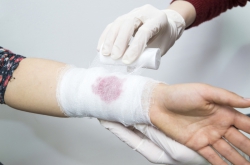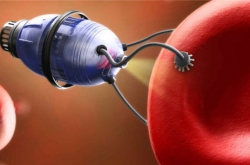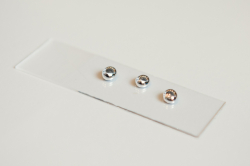Why are micro- and nanoparticles so important for medical research? Today, researchers are developing ways of using them to deliver bioactive substances directly to the cells in need of treatment, therefore reducing the overall toxicity in the organism. Moreover, nanoparticles can be used for microscopic imaging, for example by marking particles with fluorescent markers. If magnetic particles are introduced into an organism and then placed into a variable magnetic field, they can be used to locally heat the desired areas of the organism, destroying tumor tissue and cells while keeping healthy cells unharmed.
Mikhail Zyuzin began his research into the methods of delivery of bioactive substances using micro- and nanoparticles during his Master’s studies at the Philipps University of Marburg (Germany), where he studied after graduating from the Moscow Engineering Physics Institute. His choice was determined by the fact that this was the workplace of Professor Wolfgang Parak, with whom Mikhail had previously worked on nanophotonics research.
Research on the capturing of calcium-carbonate particles
This was one of Mikhail’s first projects as a Master’s student. Cells are capable of capturing particles, but the process is very much dependent on many parameters – like the particles’ physical and chemical properties, the environment they’re in and how the particles are distributed. An important one is the particles’ shape.
The project resulted in a conclusion that cells with a higher aspect ratio (ellipsoid-shaped ones, for instance) are more likely to be captured by cancer cells.

“I synthesized particles of cubic, elliptical, and other shapes and studied their interactions with cancer cells. It wasn’t a difficult project, but I still learned many new chemical synthesis methods and some physical methods, too,” – says Mikhail.
Particles for the study were made with calcium-carbonate. Its main advantage is its biocompatibility; the material also degrades inside a cell and has a porous structure, making it useful as a carrier for drug delivery.
Research on stability of polymer-coated nanoparticles
When interacting with cells, particles are commonly placed into bio-liquids rich with organic material such as proteins, growth inducers or salts. These elements can attach themselves to the particle’s surface, changing its physical and chemical properties. In the worst-case scenario, this can destabilize them and make them less likely to be absorbed by a cell. Particles are often coated with polymers to increase their stability.
For his second Master’s project, Mikhail studied the stability of particles coated with various polymers. The particles were placed into different liquids to simulate real-life biological conditions. Gold is a well-known and commonly used material in nanomedicine, which is why it was chosen as the material for the nanoparticles in question. The study helped identify the polymers that can increase the stability of particles.

Research on use of polymeric capsules for direct-to-cell delivery
As a PhD student, Mikhail continued to work on new effective direct-to-cell delivery methods. Polymeric capsules were chosen as the delivery medium, which, in addition to their non-toxicity, are also cheap and easy to synthesize. In one of his last projects in Germany, Mikhail and his team were able to liberate macromolecules from particular cells using visible light. For that purpose, golden nanoparticles were placed into polymeric capsules; when capsules inside cells were hit with a particular wavelength, they could be opened remotely, releasing the material store within. This technology would allow specialists to selectively deliver drugs to the right cells and also manipulate the cells remotely – for instance, by placing intra-cell fluorescent markers.
Biocompatible polymeric capsules can also be used in hyperthermic treatment of oncological diseases. Such a project was carried out by Mikhail as part of a Marie Curie Actions fellowship at the Italian Institute of Technology in Genoa together with Liberato Manna’s Nanochemistry group. To use nano- and microparticles in clinical environment, it’s important that we’re able to control their properties and predict how an organism might react to the introduction of these materials. For that reason, a new method was developed for encapsulating magnetic nanoparticles into polymeric nanocapsules.
Polymeric capsules remain Dr. Zyuzin’s topic of research at ITMO University; the results of his latest study have been published recently.

Working with medical institutes
Mikhail Zyuzin currently collaborates with medical and biological researchers from the First Pavlov State Medical University of St. Petersburg, the R.M. Gorbacheva Memorial Institute of Children Oncology and Hematology, and the Research Institute of Influenza, where in vivo experiments are already being carried out, meaning that the drug-delivery system is being tested on animals.
“A community of those interested in this research has formed; there are medical experts among us who can tell us exactly what they need in their practice. We’re not just working on a proof of concept, but are solving actual, relevant medical challenges,” – notes Mikhail.
Researchers at the First State Medical University are currently conducting experiments on a project for accelerated tissue regeneration in rabbits after tooth removal. For that purpose, they have synthesized special three-dimensional biocompatible scaffolds, functionalized by capsules containing pharmaceutical drugs.
Researchers at the Research Institute of Influenza, meanwhile, are working on a study in which genetic material is delivered to cells using silicon dioxide capsules. Small interfering RNA is used as the cargo, which, upon interfering with messenger RNA (such as that of a virus), causes the latter to degrade. Scientists also plan to develop ways of combating the influenza (flu) virus.
Mikhail’s colleagues from the Faculty of Physics and Engineering are also actively working on a technology for remote capsule activation; the difficulty is not only in getting the drugs delivered to the desired cells, but to control when they are deployed within the organism. The faculty’s microwave physics experts decided to take on the challenge, as microwave radiation is capable of penetrating the human body deeper than most others.

“All of this research is interdisciplinary: chemists, physicists, biologists, they are all working together and sharing their knowledge. That’s why it’s important to cooperate with different institutions and use their knowledge and equipment. For out part, we, too, try to share our knowledge and expertise to achieve the common goal. What makes our Faculty of Physics and Engineering so great is that the staff here is open to new things, ready to develop new and promising fields of science. Here, I’m at liberty to choose which areas of study I want to develop. I can keep collaborating with my German colleagues, as well as bring in new people for my projects,” – says Mikhail Zyuzin.
Dr. Zyuzin is also an organizer of the special Biotechnologies section at the METANANO-2018 conference which will be held in Sochi this September. The section will feature discussions of the latest developments and applications of metamaterials and nanoparticles in biomedicine.
Reference: Laterally and Temporally Controlled Intracellular Staining by Light-Triggered Release of Encapsulated Fluorescent Markers, Karsten Kantner, Dr. Joanna Rejman, Karl V. L. Kraft, Dr. Mahmoud G. Soliman, Dr. Mikhail V. Zyuzin, Dr. Alberto Escudero, Dr. Pablo del Pino, Prof. Dr. Wolfgang J. Parak, Chemistry a European Journal, 2018.




